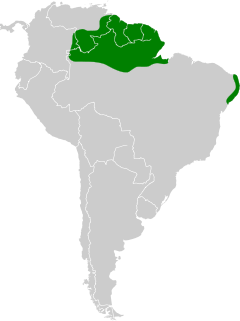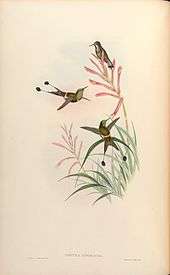Racket-tailed coquette
| Racket-tailed coquette | |
|---|---|
| | |
| Mounted specimen of Discosura longicaudus, the racket-tailed coquette. | |
| Scientific classification | |
| Kingdom: | Animalia |
| Phylum: | Chordata |
| Class: | Aves |
| Order: | Apodiformes |
| Family: | Trochilidae |
| Genus: | Discosura |
| Species: | D. longicaudus |
| Binomial name | |
| Discosura longicaudus Gmelin, 1788 | |
 | |
| Range of the racket-tailed coquette | |
| Synonyms[2] | |
|
Discosura longicauda (Gmelin, 1788) | |
The racket-tailed coquette (Discosura longicaudus; sometimes Discosura longicauda[3]) is a species of hummingbird in the family Trochilidae native to northern South America.
Taxonomy

German naturalist Johann Friedrich Gmelin described the racket-tailed coquette in 1788.[4] Its species name is from the Latin words longus "long" and cauda "tail".[5] It is sometimes considered to be the only member of the genus Discosura, as the thorntails, the other possible members of the genus, are often placed in the genus Popelairia.[6][7]
Martin Johnson Heade depicted two coquettes in his painting Two Green-Breasted Hummingbirds (c. 1863), as part of his "Gems of Brazil".[8]
Description
The species weighs about 3.4 grams (0.12 oz) and is sexually dimorphic. The male is around 10.2 centimetres (4.0 in) long and has a distinctive brilliant green head and throat with a copper-coloured abdomen. The dark purple-brown tail is 5.1 centimetres (2.0 in) long, and forked, with two very long prongs, ending with a pair of round paddle- ("racket") shaped feathers. The female is shorter with a length of 6.9 centimetres (2.7 in). It has duller green upperparts and breast, black throat bordered by white and a white belly. Its tail is grey tipped with white,[9] and lacks "rackets".[10]
Distribution and habitat
The racket-tailed coquette has a wide distribution range; it is found in northern Brazil, French Guiana, Guyana, Suriname, and southern Venezuela. It is also found on the eastern tip of Brazil[6] Its natural habitat is subtropical or tropical moist lowland forests, as well as riparian forests and scrubby savannahs.[7]
Behavior
Racket-tailed coquettes typically gather in the canopy of hapaxanth trees with other hummingbirds and steal other larger hummingbirds' nectar. They are consequently chased by the larger birds.[9]
They build their cup-sized nests out of soft plants and down 3–6 metres (9.8–19.7 ft) up a tree. Females usually have a clutch of two eggs, which are incubated for 13–14 days.[10]
References
- ↑ BirdLife International (2012). "Discosura longicaudus". IUCN Red List of Threatened Species. Version 2013.2. International Union for Conservation of Nature. Retrieved 26 November 2013.
- ↑ "Discosura longicaudus (Gmelin, 1788)". Colaboraciones Americanas Sobre Aves. Retrieved 23 February 2013.
- ↑ "Zoological Citation Notes --L". Zoological Nomenclature Resource. 14 July 2002. Retrieved 23 February 2013.
- ↑ Sibley, Charles Gald; Monroe, Burt Leavelle (1990). Distribution and Taxonomy of Birds of the World. Yale University Press. p. 148. ISBN 0300049692.
- ↑ Jobling, James A. (2010). Helm Dictionary of Scientific Bird Names (PDF). Christopher Helm. p. 229. ISBN 978-1-4081-2501-4. Retrieved 23 February 2013.
- 1 2 "Racket-tailed Coquette (Discosura longicauda)". The Internet Bird Collection. Retrieved 21 February 2013.
- 1 2 Sedgwick, Carolyn W. (2011). T. S. Schulenberg, ed. "Discosura longicaudus". Neotropical Birds. Cornell Lab of Ornithology. Retrieved 26 February 2013.
- ↑ Theodore E. Jr., Stebbins; Comey, Janet L.; Quinn, Karen E. (2000). The Life and Work of Martin Johnson Heade: A Critical Analysis and Catalogue Raisonné. Yale University Press. p. 71. ISBN 978-0-300-08183-1. Retrieved 25 February 2013.
- 1 2 Hilty, Steven L. (2002). Birds of Venezuela. Princeton University Press. p. 408. ISBN 1400834090.
- 1 2 "Racket-tailed Coquette (Discosura longicaudus)". Planetofbirds.com. 8 May 2011. Retrieved 26 February 2013.
External links
 Media related to Discosura longicaudus at Wikimedia Commons
Media related to Discosura longicaudus at Wikimedia Commons Data related to Discosura longicauda at Wikispecies
Data related to Discosura longicauda at Wikispecies- "Discosura longicaudus". Integrated Taxonomic Information System.
- Discosura longicaudus at the Encyclopedia of Life

- "Discosura longicaudus". Avibase.

